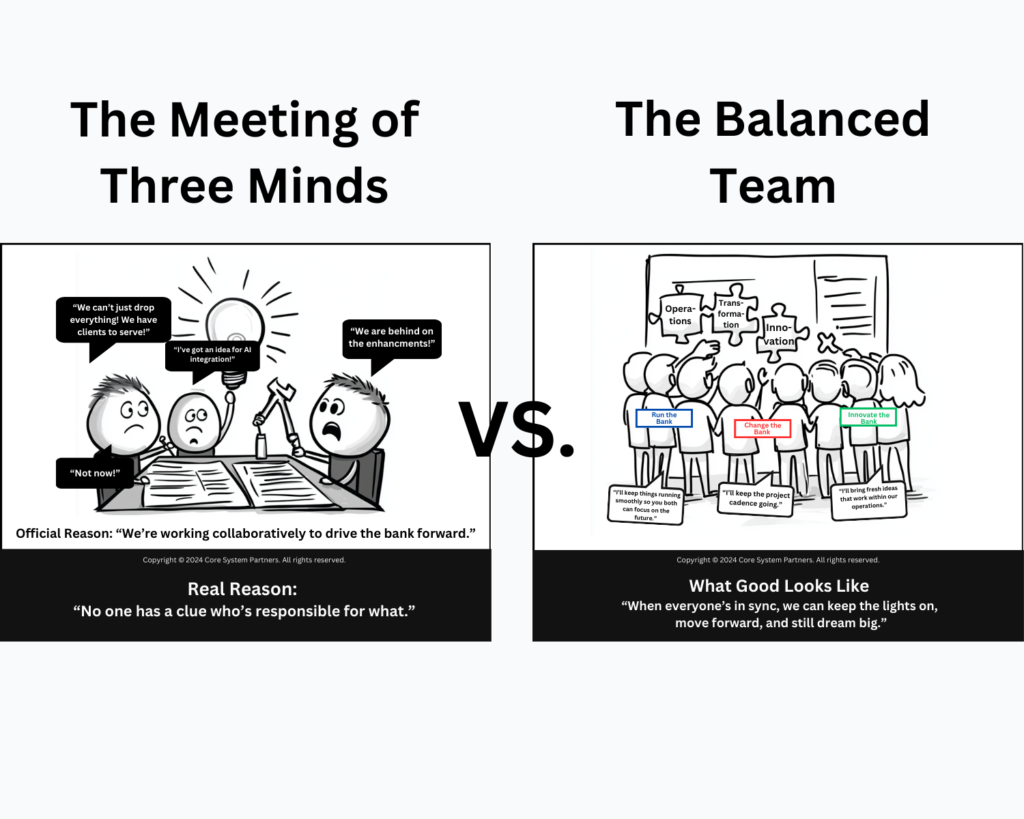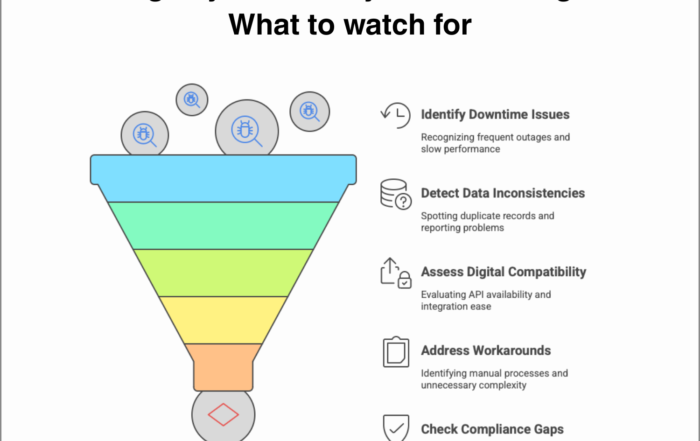Vol. 3 #1

Differentiating disarray from harmony: The left panel depicts a disjointed meeting where roles are unclear, contrasting with the right panel where a well-structured team effectively balances operations, transformation, and innovation.
From Chaos to Coordination: Lessons in Core Banking Transformation
Transforming the core operations of a bank is no small feat. It’s a whirlwind of ideas, goals, and—let’s face it—miscommunications. Two illustrations, “The Meeting of the Three Minds” and “The Balanced Team,” highlight a pivotal lesson: the difference between unstructured responsibility and a coordinated team approach. Through the lens of these cartoons, we’ll explore how this contrast plays out in the world of core banking transformations.
When Ideas Collide: Unstructured Responsibilities in Banking
In “The Meeting of the Three Minds,” we see a vivid portrayal of what happens when responsibilities lack structure. Picture this: a team sits around a table, each person bursting with ideas. One says, “We can’t just drop everything! We have clients to serve!” Another chimes in, “How about AI integration?” And yet another voice worries, “We’re falling behind on enhancements!” Each member’s passion is evident, but there’s an issue: nobody’s aligned, and nobody truly knows the bank’s priorities. Sound familiar?
We’ve all experienced this kind of meeting—energies are high, but so are tensions. Here’s the thing about unclear priorities and unstructured responsibility: it turns potential progress into chaos. The intentions are there, but without a clear path forward, ideas get lost, and priorities clash. This cartoon illustrates three key pitfalls:
- No Clarity of Roles: Without assigned roles, team members risk duplicating efforts or, worse, ignoring crucial tasks.
- Poor Alignment with Operational Goals: Innovation is crucial, but not when it disrupts core services.
- Prioritization Woes: When everyone’s idea is “urgent,” nothing truly moves forward.
In my experience, a well-structured meeting often outperforms even the most enthusiastic brainstorming sessions when no clear responsibilities are set. Banks are complex systems; we simply can’t afford to be vague.
The Power of Structure: Building a Balanced Team
Enter “The Balanced Team,” a refreshing contrast to the chaos above. This cartoon brings together three distinct roles: the Run team (keeping operations steady), the Change team (advancing project goals), and the Innovate team (bringing fresh ideas to the table). Together, they’re a balanced trio, working not in competition but in collaboration.
This coordinated approach is more than just a feel-good image; it’s a practical solution to the issues depicted in “The Meeting of the Three Minds.” When each team has a defined role, their combined efforts create synergy. Let’s break down how this structure works:
- Clear Role Assignment: Each team knows its focus. The Run team ensures stability, the Change team progresses projects, and the Innovate team pushes for fresh ideas.
- Strategic Alignment: Rather than competing, these teams contribute to a shared goal. Operational stability and project progression aren’t competing interests; they’re pillars supporting innovation.
- Unified Vision: By respecting each team’s expertise, banks can foster a culture of collaboration and progress.
This structured teamwork resembles a relay race rather than a free-for-all. One team picks up where the other left off, creating seamless progress.
Why Should You Care?
You might wonder why this matters to you. After all, you’re likely not working within a cartoon. But these illustrations hold real lessons. I’ve worked with many banking teams, and the ones that thrive are the ones that treat transformation like a marathon—not a sprint. A successful core banking transformation is not just about groundbreaking tech. It’s about the everyday, often overlooked elements: defining roles, aligning goals, and creating a team that can work together.
How Can You Move from Chaos to Coordination?
Making this shift in your own work environment doesn’t need to be drastic. Here are some actionable steps to foster a balanced team approach:
- Define Roles: Be clear about who does what. Define responsibilities down to the specifics—this avoids overlap and ensures accountability.
- Align Innovations with Core Goals: Innovation is essential, but not at the expense of operations. Ask yourself: Does this new idea support our primary mission?
- Prioritize Together: Make priority setting a team activity. This way, everyone’s input is valued, and the most urgent needs are addressed first.
- Encourage Cross-Team Communication: Teams should know what others are working on. Encourage cross-functional meetings where progress updates are shared.
If you’re involved in core banking transformations, this coordinated approach isn’t just ideal; it’s essential. When teams know their roles and share a unified vision, transformations move from chaos to meaningful, measurable progress.
Embracing the Balanced Approach in Core Banking
Core banking transformation is a journey. Whether you’re in the “Meeting of the Three Minds” phase or the “Balanced Team” stage, these cartoons remind us that every bank can benefit from structure. It’s easy to get caught up in big ideas, but the key to sustainable progress is aligning those ideas with a strong, coordinated team.
As you reflect on your own experiences, ask yourself: Are we clearly defining responsibilities and aligning innovations with our bank’s needs? The path to effective transformation isn’t just paved with cutting-edge technology; it’s built on the everyday decisions that turn potential friction into collective triumph.
#CoreBankingTransformation #RunChangeInnovateTheBank




